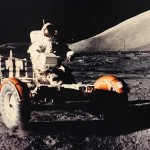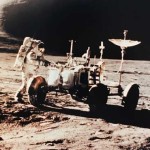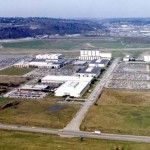Should Boeing’s Lunar Rovers be historical landmarks?
Jul 26, 2017, 6:24 AM | Updated: Aug 27, 2019, 10:10 am
The incredible Apollo program that sent astronauts to the moon nearly 50 years ago still resonates with millions of people who witnessed the launches and landings on live TV.
Even those too young to remember – and those born years after – can easily imagine the feeling that swept the world when Neil Armstrong climbed down the ladder from the Eagle and onto the surface of the moon.
Last week’s 48th anniversary of Apollo 11 generated a fair amount of media attention, as it does nearly every year.
But today’s 46th anniversary of the launch of Apollo 15 will likely go largely ignored and even forgotten.
And that’s a shame, especially around here.
Apollo 15 should be celebrated in the Northwest because it was the first of three missions that carried to the moon a “Lunar Rover” — an incredibly cool folding electric car that was designed and built right here at Boeing’s Kent Space Center.
“It was at East Valley Highway and 208th, so right in the middle of the Kent Valley, at one time surrounded by cows and now surrounded by Amazon,” said Boeing Corporate Historian Mike Lombardi.
“The Boeing Kent Space Center, which opened in 1966, was built in this fantastic period of research and development to support the space program,” Lombardi said. “And at this site, Boeing dedicated it to research and development for things that would support space travel and the research associated with space.”
Boeing was awarded the contract for the Lunar Rover in October 1969 and partnered with General Motors and a number of subcontractors. Work initially began at the NASA Marshall Space Flight Center in Huntsville, Alabama, but was soon moved to Kent.
The Lunar Rover was lightweight – about 500 pounds on Earth – and had four independently powered wheels and a built-in navigation system. It carried two astronauts and the gear necessary to study the moon’s geology. To get to the moon, the rover was folded in half and attached to the outside of the Lunar Excursion Module. Pulling on a lanyard released the rover from its container and the vehicle automatically unfolded onto the lunar surface.
Just how cool was the Lunar Rover? Astronaut David Scott knows better than anybody. NASA held an anniversary event for Apollo 15 back in 2011, and David Scott was there to share his memories. In 1971, as Commander of Apollo 15, he drove the first Lunar Rover on the moon, with fellow astronaut Jim Irwin riding shotgun.
“I gotta tell you that’s one of the most brilliant pieces of engineering this country or the world has ever come up with,” Scott said. “It was absolutely spectacular. It got us around. We went about 26 kilometers. Three different sites. And it provided the transport, not only for Jim and I but for extra geology tools and the rocks and that sort of thing. So it was a fabulous machine.”
And what did this “fabulous machine” actually look like?
To find out, one need only go to the Museum of Flight. There, you’ll find an original full-sized “engineering model” of the Lunar Rover that’s on display as part of the new Apollo exhibit.
Ted Huetter is the spokesperson for the Museum of Flight. Earlier this month, he stood in front of the display and described the Lunar Rover for a reporter.
“It looks to me about the same size as a Volkswagen Bug, Volkswagen Beetle of that era. Same sort of proportions as well,” Huetter said. “Large tires . . . are made out of this wire mesh and metal strapping arrangement. Otherwise, it sort of looks like an open dune buggy more than anything else.”
Huetter likes the way the Lunar Rover’s seats look like nylon-webbed aluminum lawn chairs from the 1960s. He says that the vehicle is, in a way, emblematic of the era in which it was created.
“[In the] late 1960s and early 1970s, what is more American than a car?” Huetter said. “So if we’re going to go to the moon, well, we’ve gotta have a car, too.”
Boeing designed and built several Lunar Rovers from late 1969 to early 1972, and a total of three were actually used on the moon to cover far more distance – exploring farther and collecting more rock samples – than astronauts could on foot.
In October 1971, Apollo 15 astronauts David Scott and James Irwin visited the Boeing Kent Space Center to show their gratitude for the company’s work on the Lunar Rover. A dinner was held, awards were handed out, and employees rubbed shoulders with the Apollo celebrities. Irwin told The Seattle Times that riding in the rover was like a “combination of skiing and tobogganing.”
Nearly 50 years later, those three rovers aren’t skiing or tobogganing anymore, but they do remain parked there still; one each from Apollo 15, 16 and 17. With no atmosphere on the moon, the rovers are likely still in very good shape, perhaps coated with a thick layer of moon dust.
And that’s how it was thought the rovers and all the Apollo gear left on the moon would always be, left in place as a kind of inadvertent “living museum” of that very short era of human travel from earth to and from its only natural satellite.
But all that may be about to change. With the era of space tourism on the horizon – with companies such as Elon Musk’s SpaceX promoting lunar travel – there’s concern among some preservationists here on Earth that good-intentioned human visitors will one day destroy all six Apollo landing sites.
And there’s already a handful of people working to stop that from happening, including Dr. Beth O’Leary, a professor of anthropology at New Mexico State University.
O’Leary told NPR last week that preserving Apollo sites is going to require an international effort.
“It has to be a series of agreements between nations so when we go back to the moon these very early sites, these sites that are the most extraordinary, in my opinion, will be preserved,” O’Leary said.
International agreements are all well and good, but they might take a long time to come together, and could just as easily unravel. Fortunately, there may be something that the people of King County can do in the meantime.
Since the Lunar Rovers were designed and built in King County, local preservationists might be able to help save them, and perhaps help save the Apollo landing sites, too.
Todd Scott is the Preservation Architect for King County’s Historic Preservation program, which most people associate with historic mansions, vintage barns and ornate railroad stations. But Todd Scott says King County’s program has always been about innovation and pushing the envelope of what’s commonly accepted as historic preservation.
Would the Boeing designed and built Lunar Rover qualify to be designated as an official “King County Landmark,” and thus be eligible for protection?
“I’ve taken a look at our code and I think it probably would, actually,” Scott said earlier this week, pointing to other vehicles that have been so designated, such as railroad cars and wooden boats.
But those railroad cars and boats are generally still here in King County – not a quarter-million miles away on the moon.
“Most of our code doesn’t say that [the potential landmark] has to be in King County,” Scott said. “So I think it’s feasible. I’d need to talk certainly with our legal counsel to see what they’d think.”
“But I think it would be a really good opportunity to designate something and bring some attention to the fact that its history is here,” Scott said. With only minimal staff working on historic preservation in King County, Scott says, the landmark nomination for the Lunar Rovers will probably have to come from a member of the community who’s willing to put in the time.
Todd Scott also points out, however, that it would be tough to enforce the landmark designation from 240,000 miles away. But, he says, designating the Lunar Rovers as landmarks might help raise awareness of the fragility of those Apollo sites and help with larger preservation efforts such as what Beth O’Leary is pursuing.
As it turns out, in addition to the Lunar Rovers, there’s actually a lot of hidden history around the role that Boeing and Kent played in the Apollo program.
Mike Lombardi, who provided most of the photos for this story, also knows more than just about anybody when it comes to Boeing history.
“The other part of [the Boeing space story] is that when Apollo and Saturn, in particular, started up, Boeing was a key player in the Saturn booster,” Lombardi said. “We built the first stage of the booster. And all of that work, the developmental work and the leadership of that program, was in Kent.”
Boeing’s history with the space program – and the track record of the Museum of Flight – may have contributed to the recent decision by the Smithsonian Institution regarding one very important Apollo artifact that did return from the moon.
Beginning in early 2019, the Museum of Flight will display the Apollo 11 Command Module, and it will remain on display for most of the year, including for the July 2019 50th anniversary of that history-making mission to the moon.
Want to help save the Lunar Rovers?
If you’re a high school teacher and you want to put together an amazing class project for the coming school year, preparing the King County Landmark Nomination Form for the Lunar Rover might be a perfect way to get involved in the community and give your students a unique learning opportunity. A community member needs to take the lead on preparing the nomination form, and it’s a perfect class project because the work is a combination of research and writing. Todd Scott at King County says he is willing to help, as is KIRO Radio’s Feliks Banel. If you’re a teacher and are interested in the project, please send an email to Feliks Banel.



















